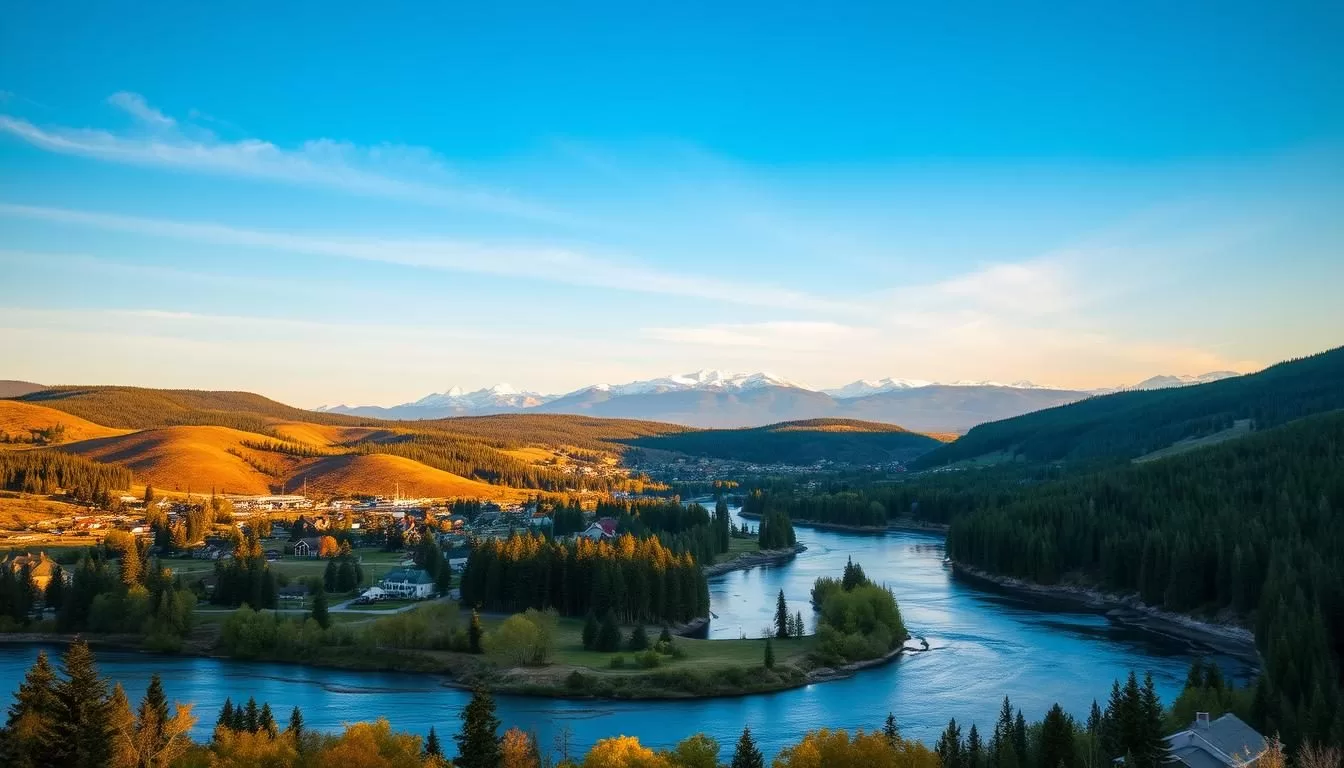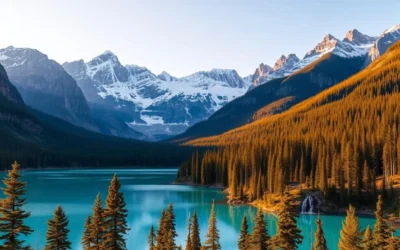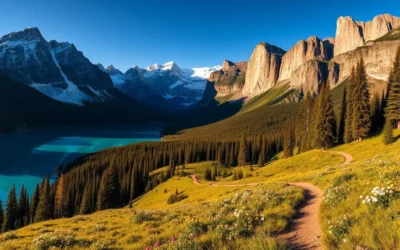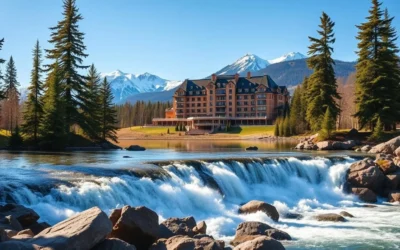✓ Accommodations ✓ Flights ✓ Rental Cars ✓ Tours & Activities
Planning a trip to Canada can be a thrilling experience, but the time of year you choose to visit can greatly impact your travel experience.
Understanding the weather patterns and seasons will help you prepare for the conditions you’ll encounter, ensuring you’re not caught off guard.
Whether you’re looking to enjoy outdoor activities like hiking or skiing, or simply want to make the most of your trip, knowing the best time to visit is crucial.
By considering factors like weather and crowd levels, you can have a more enjoyable and stress-free experience.
Understanding Canada’s Diverse Climate
Canada’s climate is as diverse as its landscapes, offering a range of experiences for travelers throughout the year. The country’s vast geography means that the climate varies significantly from one region to another.
Ontario’s climate, for instance, is defined by four distinct seasons: spring, summer, fall, and winter. Each brings its own charm and challenges. Summers are warm, with average temperatures ranging from 68°F to 82°F, perfect for outdoor festivals and water activities. Winters, on the other hand, often see temperatures drop below freezing, creating ideal conditions for ice skating and snow sports.
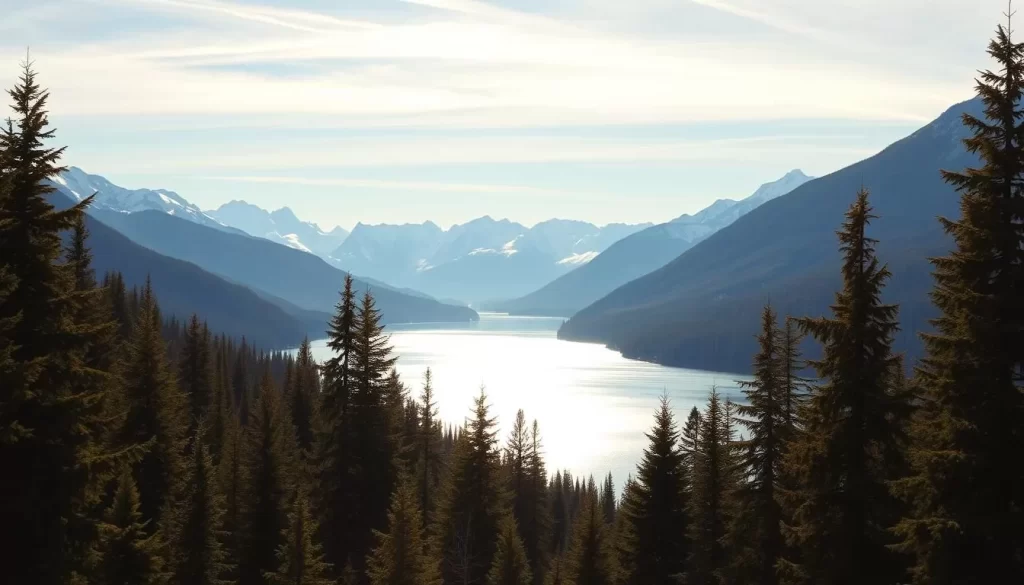
Four Distinct Seasons Across the Country
The experience of these four distinct seasons is a hallmark of Canada’s climate. As you travel across the country, you’ll notice dramatic variations in weather patterns over time. The changing season brings different atmospheres and opportunities for travelers.
| Season | Weather Conditions | Popular Activities |
|---|---|---|
| Spring | Mild temperatures, rain showers | Hiking, festivals |
| Summer | Warm to hot temperatures | Outdoor festivals, water activities |
| Fall | Cool temperatures, foliage | Leaf peeping, harvest festivals |
| Winter | Cold temperatures, snow | Skiing, ice skating |
Throughout the year, Canada’s diverse climate offers a range of experiences. Understanding these variations can help you plan your trip according to your preferences, whether you’re looking for outdoor adventures or cultural experiences.
Canada: Best Months for a Weather-Savvy Trip
Planning a trip to Canada requires understanding the best time to visit for an optimal experience. The country’s diverse climate means that different seasons offer unique advantages and experiences.
Peak Season: June to August
Summer is the peak season in Canada, ideal for warm weather enthusiasts. From June to August, temperatures often peak around 81°F, making it perfect for outdoor activities and exploring cities or nearby attractions. However, this is also the busiest period, so booking accommodations and popular attractions in advance is essential. You’ll enjoy festivals, outdoor events, and long days, but be prepared for larger crowds.
Shoulder Seasons: May-June and September-October
The shoulder seasons, which include May-June and September-October, offer a great balance between pleasant weather and fewer crowds. During these periods, you can enjoy mild temperatures and the beauty of nature, whether it’s spring blossoms or autumn foliage. October is particularly great for visiting national parks, with fewer tourists and lower accommodation rates, making it an ideal time for those seeking a more relaxed experience.
Off-Peak Season: November to April
The off-peak season, from November to April, brings its own charm, with winter sports and festive events being major attractions. If you’re a fan of skiing, snowboarding, or ice skating, this is the best time to visit. Additionally, you can enjoy budget-friendly accommodations and unique seasonal experiences. For those who prefer milder winter conditions, the southern regions of Canada offer a more temperate climate during these months.
Summer in Canada: June to August
Canada comes alive during the summer months, offering a wide range of activities and experiences. The warm weather and long days make it an ideal time to explore the country’s diverse regions.
Temperature Ranges and Weather Patterns
Summer temperatures in Canada vary across different regions. July is the hottest month, with average highs reaching 81°F. Coastal areas tend to be milder, while inland provinces can experience warmer temperatures, often reaching the 80s°F. It’s essential to pack accordingly and stay hydrated during your visit.

Popular Summer Activities and Festivals
Summer is the perfect time to enjoy outdoor activities in Canada, such as hiking, swimming, and water sports on the Great Lakes. The country also hosts numerous festivals and events during this time, including the Calgary Stampede and the Montreal Jazz Festival. These events showcase Canada’s rich cultural heritage and provide a unique experience for visitors.
Pros and Cons of Summer Travel
While summer is the peak tourist season in Canada, it has its advantages and disadvantages. The ideal weather and long days make it an excellent time to explore the country’s attractions. However, it’s also the busiest season, with larger crowds and higher prices. To make the most of your summer visit, plan ahead, and consider visiting popular destinations early in the morning or later in the evening to avoid the crowds.
Fall in Canada: September to October
Canada’s fall season, spanning September to October, offers a unique blend of natural beauty and cultural experiences. As the summer fades, the landscape transforms into a vibrant tapestry of colors, making it an ideal time to visit Canada.
Fall Foliage and Temperature Trends
The fall foliage in Canada is renowned for its spectacular display of autumn colors. During September and October, temperatures gradually drop, creating comfortable conditions for outdoor activities. Daytime temperatures range from 62°F in September to 50°F in October, while nighttime temperatures can dip to around 40°F.

Harvest Festivals and Cultural Events
Fall is a season of harvest festivals and cultural events across Canada. The Toronto International Film Festival (TIFF) in September attracts visitors from around the world. Other notable events include wine festivals in the Okanagan Valley and Thanksgiving celebrations. These festivals offer a glimpse into Canadian culture and are a great way to experience the local heritage.
| Event | Location | Date |
|---|---|---|
| Toronto International Film Festival (TIFF) | Toronto | September |
| Okanagan Valley Wine Festival | Okanagan Valley | September-October |
| Thanksgiving Celebrations | Various Locations | October |
Why Fall Might Be Canada’s Best-Kept Secret
Fall offers a perfect balance of comfortable weather, stunning natural beauty, and fewer crowds, making it an attractive season to visit Canada. With shoulder season pricing and still-excellent access to most attractions and activities, travelers can enjoy a more relaxed and budget-friendly experience.
Winter in Canada: November to March
As the last wisps of autumn disappear, Canada transforms into a winter wonderland from November to March. This period is characterized by cold temperatures and significant snowfall, making it an ideal time for various winter activities.
Winter Weather Expectations
During the winter months, Canada experiences cold temperatures, with January being the coldest month, averaging lows of 16°F. The snowfall varies across the country, with some regions receiving heavy snow, while others remain relatively mild.
Winter Sports and Seasonal Activities
Canada is renowned for its world-class winter sports opportunities, including skiing, snowboarding, ice skating, and dog sledding. The country’s diverse landscapes offer a range of activities for all skill levels, from beginners to professionals. You can enjoy skiing in the Canadian Rockies or ice skating in Ottawa’s Rideau Canal, a UNESCO World Heritage Site.

Holiday Celebrations and Winter Festivals
Winter in Canada is not just about the cold; it’s also a time for festive celebrations and events. You can experience the magic of the Toronto Christmas Market, Quebec City’s Winter Carnival, or Ottawa’s Winterlude. These events showcase Canadian culture and hospitality, making your visit to Canada a memorable experience.
When you visit Canada during the winter season, you’ll find that the country’s cold weather is more than made up for by its warm and welcoming atmosphere. Whether you’re looking for adventure or just want to enjoy the winter landscapes, Canada has something to offer.
Spring in Canada: April to May
With the arrival of spring, Canada awakens from its winter slumber, presenting a wonderful opportunity to visit Canada as the country’s landscapes transform into a vibrant tapestry of colors and life.
Spring Thaw and Temperature Patterns
Spring brings a mix of lingering winter chill and the warmth of approaching summer, resulting in unpredictable weather patterns across Canada. Temperatures gradually rise from 32°F in March to 57°F in May, making it a transitional period. April is particularly noteworthy for its rainfall, averaging 2.4 inches of precipitation. This variability means that layered clothing is essential for comfort during your visit.
Spring Activities and Natural Phenomena
As spring takes hold, Canada’s natural beauty comes alive, offering numerous outdoor activities and spectacular natural phenomena. You can witness wildlife reemerging from their winter habitats, enjoy the vibrant blooms of wildflowers, and marvel at the peak flow of waterfalls. The season also brings fewer crowds at popular destinations, making it an ideal time for those seeking a more serene experience. From maple syrup festivals in the east to spring skiing in the Rockies and cherry blossom viewing in Vancouver, there’s no shortage of exciting events to enjoy.
Regional Weather Guide: Where to Go When

The vast and varied landscapes of Canada mean that the best time to visit can differ significantly from one region to another. Understanding these regional differences is key to planning a trip that suits your preferences.
Eastern Canada: Ontario and Quebec
Eastern Canada, including Ontario and Quebec, experiences a humid continental climate with hot summers and cold winters. Cities like Toronto and Ottawa have distinct weather patterns. In Toronto, winter temperatures rarely dip below -20°F, while summer highs can reach around 80°F. Spring, from March to May, is a great time to visit Toronto, with temperatures ranging from 27°F in March to 66°F in May, making it ideal for exploring parks like High Park.
Western Canada: British Columbia and Alberta
Western Canada, encompassing British Columbia and Alberta, offers varied climate conditions. Coastal British Columbia has a mild, rainy climate, while the interior and Alberta experience a drier, more extreme continental climate. The Rocky Mountains in Alberta create a unique mountain weather pattern, making it a popular destination for outdoor activities like hiking and skiing.
Northern Canada and the Territories
Northern Canada and the territories are characterized by extreme seasonal variations, with long, cold winters and short, cool summers. Visiting this region requires careful planning and preparation for the harsh weather conditions. However, the unique landscapes and natural phenomena, such as the Northern Lights, make it a fascinating destination for adventurous travelers.
Planning Your Trip Around Canadian Festivals and Events

Planning a trip to Canada around its festivals and events can be a game-changer for travelers. Canada’s diverse cultural landscape is showcased through numerous festivals that take place throughout the year, offering a unique experience for visitors.
Signature Events by Season
Canada’s festivals are seasonal, with each time of the year bringing its own unique events. In the summer, music festivals like the Toronto Jazz Festival and Osheaga are highlights. Fall brings harvest festivals, while winter is the time for carnivals like the Quebec Winter Carnival. Spring welcomes cultural gatherings and renewal festivals.
Cultural and Sporting Events Worth Planning For
Major sporting events such as the Montreal Grand Prix and the Calgary Stampede attract visitors worldwide. Cultural events like Canada Day celebrations on July 1st are not to be missed. These events offer a chance to experience Canadian culture firsthand and connect with locals.
By planning your trip around these festivals and events, you can create a more immersive and memorable travel experience. Whether you’re interested in cultural displays, music, or sports, Canada has something to offer. Advance planning for tickets, accommodations, and transportation will ensure a smooth trip.
Budget Considerations for Seasonal Travel
When planning your trip to Canada, understanding the budget implications of seasonal travel can significantly impact your overall experience. Your travel costs can fluctuate significantly throughout the year, with peak summer months commanding premium prices and off-season periods offering substantial savings.
Price Fluctuations Throughout the Year
Canadian travel costs vary greatly across different seasons. For instance, flights on Tuesdays can be up to 15% cheaper than weekend trips. Being flexible with your travel dates can lead to significant savings.
| Season | Accommodation Prices | Flight Prices |
|---|---|---|
| Peak Season (June-Aug) | High | High |
| Shoulder Season (May-Jun, Sep-Oct) | Moderate | Moderate |
| Off-Peak Season (Nov-Apr) | Low | Low |
Finding Deals on Accommodations and Flights
To save on accommodations, consider booking during the shoulder season when prices drop by 20-50% compared to the peak season. You can also look into budget-friendly options like hostels, which can save you 50-70% compared to hotels.
Booking in advance is another smart move, as early reservations can save you 10-30% on flights.
Money-Saving Tips for Each Season
Being flexible and open to different accommodation options can significantly reduce your travel costs. For example, dormitory-style accommodations can offer substantial savings. Additionally, planning your trip around Canadian festivals and events can help you make the most of your budget.
- Consider midweek travel for cheaper flights.
- Look for package deals that include accommodations and activities.
- Use loyalty programs to save on travel expenses.
Packing Essentials for Canada’s Weather
To make the most of your Canadian adventure, it’s essential to pack wisely, considering the country’s changeable weather. Canada’s climate varies significantly across seasons and regions, making it crucial to be prepared.
Seasonal Packing Lists
Understanding the season you’re traveling in is key to packing effectively. For summer, include lightweight, breathable clothing and sun protection. In winter, pack insulating layers, waterproof gear, and warm accessories. Spring and fall require versatile clothing that can adapt to fluctuating temperatures.
- Summer: Lightweight clothing, sunscreen, sunglasses
- Winter: Insulated jackets, warm hats, gloves
- Spring/Fall: Layered clothing, waterproof jackets
Layering Strategies for Unpredictable Weather
Layering is a vital strategy for dealing with Canada’s unpredictable weather. Start with a moisture-wicking base layer, add a warm mid-layer like a fleece, and finish with a waterproof outer layer. This approach allows you to adjust to sudden temperature changes, especially during spring and fall.
| Layer | Purpose | Example |
|---|---|---|
| Base Layer | Moisture-wicking | Thermal tops |
| Mid-Layer | Insulating | Fleece jackets |
| Outer Layer | Waterproof | Waterproof jackets |
Conclusion
With its vast and varied climate, Canada offers something unique in every season, making it a year-round destination. As you’ve discovered, the best time to visit Canada depends on your preferences and what you want to experience.
Whether you’re drawn to summer’s warmth, winter’s snow, spring’s renewal, or fall’s foliage, Canada has a season that’s perfect for you. By understanding the country’s diverse climate and planning your trip accordingly, you can ensure a memorable and enjoyable travel experience.
From outdoor activities like hiking and skiing to cultural events and festivals, Canada’s diverse seasons offer a wide range of experiences. Use this guide to plan your trip during the best months for your interests, and you’ll be sure to have an adventure you’ll never forget.
Now that you’re equipped with the knowledge of Canada’s seasons, it’s time to start planning your trip. With the right preparation, you can turn any season into an unforgettable journey.
The above is subject to change.
Check back often to TRAVEL.COM for the latest travel tips and deals.
